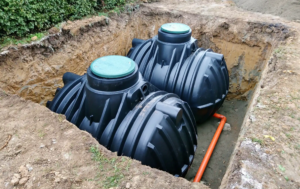Plumbing is a skilled trade that requires specialized training and hands-on experience. Many plumbers work as independent contractors and may choose to operate their own businesses.

Plumbers Sarasota inspect water supply lines for leaks, corrosion and damage using specialized tools and equipment. They also check water pressure to ensure it falls within acceptable ranges.
A well-maintained sewer line ensures that wastewater is removed effectively. This prevents clogs, leaks, and other unpleasant situations that can impact the comfort and reputation of a home or business. Professional plumbers use specialized equipment to remove organic matter, sanitize lines, and inhibit the growth of bacteria and other organisms that can cause health risks. When necessary, they also provide drain cleaning and other repair services to keep lines in good condition.
One of the most significant benefits of regular sewer line maintenance is that it can save homeowners from costly emergency repairs. When problems are detected and addressed quickly, they can reduce the risk of sewage backups, pipe bursts, and extensive water damage.
As a homeowner, you can do your part to help avoid these issues by avoiding the flushing of inappropriate items. For example, wet wipes, sanitary products, paper towels, and grease should never be disposed of down the drain or toilet. Installing strainers in sinks and running hot water occasionally can also help keep the line clear of clogs.
Signs of a problem with your sewer line include slow draining, frequent clogs, and foul odors near or in the yard. A gurgling sound when using the toilet is another common warning sign of a blockage or other issue.
If you notice these signs, call your local plumbing professionals right away. They can assess the situation and recommend a solution, ranging from sewer rodding to complete line replacement. In the case of a replacement, they can guide you through the regulatory process and ensure that your new line is installed correctly, protecting your property value and ensuring safe, effective operation.
Sewer line repairs and replacements can be complex, time-consuming, and expensive. Hiring a plumber with the proper expertise can ensure that your project is completed on time, within budget, and without any unnecessary hassle. By utilizing advanced tools and techniques, such as sewer camera inspections, professionals can identify and fix any issues with your sewer line. This keeps your home or business functioning as it should and protects against costly repairs down the road.
Sewer Cleaning
When hair, food scraps, grease, and other debris build up inside your drain lines, it can cause serious plumbing problems. Unlike clogged toilets, which you can usually resolve with a plunger, sewer line blockages are a lot more dangerous. Left unchecked, they can lead to sewage backups and other costly repairs. But regular sewer cleaning can help you avoid these issues.
The most common sign that you need sewer cleaning is multiple drains backing up at once or gurgling sounds from your toilets. If you suspect a problem, call your plumber right away. They’ll use specialized equipment to evaluate your line and determine the best way to clean it.
Your sewer line is responsible for transporting all of the waste from your home’s drains to the municipal sewer system or septic tank. But if this line gets clogged with tree roots, garbage, or solid waste, it can cause major problems for your entire plumbing system. Fortunately, professional plumbers can use special tools to thoroughly clean your sewer line and remove any obstructions.
There are several different methods for sewer cleaning, and your plumber will choose the one that’s right for your situation. For example, if your sewer line is heavily clogged, your plumber may use mechanical cleaning to break up and remove the blockage. This method involves using power rodders, hand rodders, or drain augers to cut, scrape, and remove large blocks of waste.
If your sewer line is narrower and has more minor blockages, your plumber might use chemical cleaning to break down and flush away the obstruction. This method involves pouring government-approved chemicals into the line that are safe for your pipes.
For more severe blockages, your plumber might use hydraulic cleaning. This technique uses a nozzle attached to a hose that’s fed into the sewer line. When the nozzle is positioned over the blockage, the plumber releases water at high pressure to clear the pipe.
In addition to clearing out clogged drains and preventing backups, sewer cleaning can also improve your home’s energy efficiency by keeping wastewater moving through the line. If you have questions about how often you should schedule cleaning services for your sewer line, ask a professional plumber. They’ll be able to assess your line and recommend a routine that will keep it running smoothly for years to come.
Sewer Repair
When your sewer line is damaged, it can cause a host of problems that may affect the entire plumbing system. These issues include clogged drains, foul odors from your drains and yard, slow-draining sinks and toilets, and even sewage backups. Knowing the warning signs can help you identify when it’s time to call for professional assistance.
Choosing the right plumber for your sewer repair is crucial to ensure quality work and minimized costs. Look for a contractor who specializes in this type of work, as they’ll have the experience and skills needed to address your specific needs. You should also check that they’re licensed and insured, as this will protect both you and the plumber in the event of any accidents or damages during the project.
The most common cause of sewer line damage is a clog or blockage. This can occur when debris such as tree roots, grease, or mineral buildup accumulates and prevents water from flowing properly through the pipes. A plumber will use specialized equipment to clear any obstructions and restore proper flow.
Another common problem is broken or cracked pipes. These may develop over time due to soil movement, freezes, or simply age and wear. If left untreated, these cracks can allow waste to leak out of the pipe and into the surrounding soil. The resulting sinkhole can create significant damage to your property and require costly repairs.
To determine the exact nature of your sewer line problem, specialists often use sewer camera inspections. These involve inserting a small waterproof camera into the pipes to view the insides of the lines. The footage is then analyzed, helping specialists to pinpoint the exact location and severity of the issue. This allows them to recommend the best course of action for repair. Options for repairing your sewer line may include trenchless methods such as pipe lining or hydro jetting, which can often be performed without the need for excavation. If the damage is severe, however, a complete sewer line replacement may be necessary. This can be expensive but is often the quickest and most effective solution.
Sewer Replacement
When repairs aren’t enough and the line needs to be replaced, it’s a major undertaking. A plumber will need to dig large trenches in the yard to expose and replace the damaged pipes. Depending on the layout of your property and its landscaping, this could take 1 to 2 days or more.
Knowing a sewer replacement timeline is important to help homeowners make plans for minimizing disruptions during the process. It will also allow them to prepare for costs associated with alternative arrangements or temporary accommodations. Knowing the estimated timeline can also help homeowners budget for the cost of a new line and anticipate any other potential expenses related to the replacement process.
A broken sewer line can have a number of effects on your home, including sewage backups, water damage, and foul smells. If you’re experiencing any of these issues, contact a plumber right away to schedule a sewer inspection. Your plumber can use a camera to locate the break and identify the cause. After inspecting the line, they’ll determine if it can be repaired or if replacement is necessary.
Sewer replacement can be more complex than repair, as the line is located underground and has to be carefully removed and reinstalled. It may also require excavation, which can add to the overall cost and lead to a longer project duration. A skilled plumber can minimize these factors by using a method called trenchless sewer line replacement.
One common reason for sewer replacement is poor installation. If your line was installed incorrectly, it can become damaged and lead to expensive repairs later on. In addition, errors in installation can cause leaks and blockages that are beyond the scope of a repair.
Other reasons for sewer replacement include extensive damage and an aging infrastructure. A sewer line that has been damaged by tree roots or has deteriorated significantly can lead to failure over time. Additionally, a broken line can cause sewage to back up into the house, which poses serious health and safety risks.
If you’re considering a sewer replacement, an experienced plumber can provide a thorough inspection and recommend the best solution for your home. They’ll take into account the layout of your yard, your piping system, and any structures or landscaping that need to be moved or protected during the process. In addition, they’ll have the skills and equipment needed to navigate any regulatory landscape and ensure that your sewer replacement meets local codes.
